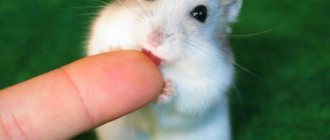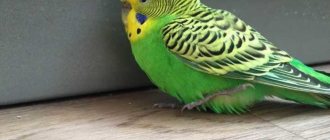Why doesn't a hamster open its eyes?
So why doesn't the hamster open its eyes? Below we will look at some pathological reasons, the action of which leads to the inability of the animal to open its eyelids.
Some of them are not too dangerous, while in other cases the owner needs to immediately call a veterinarian.
Entry of a foreign object
One of the most common causes of eyelid sticking is the entry of a foreign object. As a rule, its role is played by sawdust and other “elements” of the litter. There are, however, cases when, as a result of using free sawdust from a nearby sawmill, a hamster gets metal shavings in the eye. Therefore, for the sake of your pet’s health, you shouldn’t skimp on the quality of its bedding! In all of the above situations, the hamster cannot open its eyes for two reasons:
- Due to the strong pain reaction, the animal does not want to open its eyes again.
- Since a foreign body is always “teeming” with pathogenic and conditionally pathogenic microflora, the damaged organ will certainly become inflamed and inflammatory exudate will begin to be released. The latter glues the edges of the eyelids so securely that the hamster can squeak in pain from fear, but will not open his eyes.
Treatment
Only a veterinarian can make a correct diagnosis, having found out why the hamster’s eyes do not open, and prescribe treatment after diagnostic measures. Therapy will depend on the underlying disease. If the doctor determines that the cause of the eye problem is an infection, then antibacterial medications will be required.
If your hamster has a stuck eye, you need to treat it as soon as your veterinarian makes a diagnosis. In addition to therapy, you will need to disinfect the cage, feeder, drinking bowl, and also change the bedding. It is important to carefully monitor your diet both during treatment and after successful completion of therapy.
If allergens are the cause of the disease, it is important to eliminate the animal’s contact with them. Allergies can be to food, cosmetics and detergents, animal hair, pollen from indoor plants. Antihistamines will help, as well as antibiotics for severe suppuration.
The owner must understand that self-medication leads to various complications. When the first symptoms appear, you need to contact a veterinary clinic and begin treatment in a timely manner.
Other causes of eye sticking in hamsters
Let's look at other causes of eye sticking in hamsters:
- Ophthalmological pathologies in pets with fluffy, long hair. It happens that it either gets into the eyes, or begins to grow so that the hairs rest directly on the surface of the cornea. For this reason, such pets should regularly trim the overgrown fur around their eyes.
- If grass from the nearest roadside is used to feed the animal , the “homa” may get stubble in the eye (these pets are not particularly brilliant, unfortunately).
- If the animal regularly runs around the house in free-range mode, then even more troubles can happen to its eyes. A pet can injure its vision organs with small elements of children's toys and various household garbage. In addition, in this case, household chemicals may get into the animal’s eyes, which will almost certainly lead to the hamster’s blindness.
Non-inflammatory diseases
Cataract
If your hamster's eye is cloudy, it could be a cataract - a metabolic disorder in the lens. The disease leads to
blindness. Eye drops are not effective, and surgery is not performed in either the Djungarian or the larger Syrian hamster. When the owner notices that the hamster's eye has turned white, this is a reason to consult a doctor, despite the fact that there is no treatment. Cataracts in a hamster are a sign of old age, decrepitude of the body, and in a dwarf or Campbell's hamster it is an indirect sign of diabetes. In both cases, treatment of the underlying disease is required to prolong the pet's life.
A thorn on the surface of the cornea is not a cataract, but the consequences of an injury, a scar. With cataracts, something light is visible in the depths, in the area of the pupil.
Glaucoma
An increase in intraocular pressure is accompanied not only by enlargement and bulging of the eyeballs, but also by severe pain. A doctor makes a diagnosis of glaucoma after measuring the pressure in the eye. It is not possible to normalize it with drops; the only treatment is enucleation to stop the pain. If you don't do anything, the eye will eventually burst. It is difficult to say why such a pathology occurs. Since Campbell's hamsters are most often affected, rarely Djungarians and never Syrians, a genetic (hereditary) nature is assumed.
Oncology
A small bump on a hamster's eyelid may be a tumor. Oncology can also be the reason why one eye suddenly becomes larger than the other. Ornamental rodents are susceptible to cancer and there is no effective treatment in such cases.
Providing first aid to a sick hamster
Timely provision of first aid to a sick animal is extremely important:
- The pet is given complete rest and is not disturbed unless unnecessary.
- In some cases, it is possible to remove foreign objects and debris from the animal’s eyes. To do this, experienced breeders use a small syringe and warm saline solution.
- If an allergy is suspected, your pet can be given a couple of drops of Zyrtec or a similar drug. Diphenhydramine and other medications in tablet form should not be given, as dosing problems may arise.
Tumors and neoplasms
Tumors (malignant, benign), pathological growths on the body, legs. ears is a fairly commonly diagnosed pathology in rodents, which can develop for a variety of reasons. Bumps can appear due to injuries, severe bruises, or falls from a height. To begin treatment, you need to establish a diagnosis, so take your pet to a veterinarian.
For benign and malignant tumors, surgical treatment will be prescribed. If the cancer is localized in a hard-to-reach area (oral cavity), or the tumor has metastasized, veterinarians recommend euthanizing the hamster, since no treatment method will give the desired result.
Well, the most serious category of diseases are tumors and neoplasms, which are very common in hamsters. And, it may not necessarily be cancer, as many rodent owners think, but also the consequence of an unfortunate lump as a result of a bruised limb. But, in order for all your doubts to be dispelled and the rodent to be correctly diagnosed, contact a specialist.
Treatment for stuck eyes in hamsters
As a rule, treatment of stuck eyes in hamsters does not cause any particular problems:
- If the entry of a foreign body was not immediately detected and it has reached inflammation, the animal is prescribed broad-spectrum antibiotics (or other antibacterial agents, or antifungal drugs).
- In some cases, anti-inflammatory corticosteroids may be required.
- To prevent eye sticking, a sick hamster needs to be washed regularly. To do this, you can use both regular saline solution and more “vigorous” means in the form of a solution of furatsilin. Before use, all these products must be warmed to room temperature, since washing the eyes with cool solutions can only aggravate the course of the disease.
- If inflammation and subsequent gluing of the eyelids is caused by foreign bodies getting into the pet’s eyes, and it was not possible to remove this debris with regular washing, they resort to surgical removal of all excess. You should not try to pull them out on your own, as special tools and appropriate skills are required.
Main reasons
Rodents are often susceptible to infectious and age-related eye diseases. If it is difficult for a hamster to open its eyes, it is imperative to figure out the cause of the problem, otherwise irreversible consequences will begin.
Allergy
Tearfulness can occur due to the consumption of exotic fruits and other unusual delicacies. Also the cause is the detergents used when processing cells, as they contain a large number of chemical compounds.
Unsanitary conditions
One of the common causes of eye diseases in rodents. Over time, microbes begin to multiply in the litter and bedding. And hamsters often sit and hide in them from people, so it is important to periodically change them.
Trauma and injury to the cornea
Hamsters can easily injure themselves. They can prick themselves on sharp oat straws, or a small particle of filler can penetrate under the eyelids. Inflammation of the cheek is also a factor in the onset of the disease. If several rodents live together in a cage, they can be injured during a fight.
With a fresh wound, the hamster squints due to the tearing of the eye. The affected area hurts, the pet is nervous, moves little and constantly hides. If the cornea is injured, microbes may enter and the eye may become sour.
Before the examination, it is necessary to clean the eyelids. When rinsing, do not use hydrogen peroxide or other liquids that harm the mucous membrane. If your eyes are stuck together, you need to soak your eyelids; under no circumstances try to force them open.
The easiest way is to soak it with a cotton swab dipped in boiled water. You cannot use regular cotton wool, as its fibers can remain on the eyelids or eyelashes and cause re-infection.
It happens that the eyelid is injured, in which case you need to lubricate it with tetracycline ointment twice a day.
Weak immunity
Eye ailments in hamsters can be in addition to tuberculosis, pneumonia and viral infections of the respiratory tract.
In what cases should you contact a veterinarian?
Sometimes trying to help a pet on your own is the worst idea, since unnecessary delay can lead to very sad consequences. Here are the cases in which you need to contact a veterinarian immediately:
- The animal feels so bad that it eats poorly or refuses food altogether. If your pet refuses water, you should call a doctor immediately, regardless of the time of day.
- Severe weakness and apathy. For normally active hamsters, these signs are atypical and strongly indicate serious health problems.
Bladder or kidney infection
A common illness in hamsters is bladder or kidney infections. The main symptoms are frequent urination and the presence of blood in the animal's urine. The hamster's squealing when urinating and lethargy directly indicate a disease.
If such a disease occurs, the hamster is given antibacterial therapy, which is prescribed only by a doctor. Providing the animal with warmth and drink is a prerequisite for recovery. During the treatment of the disease, the frequency of cleaning the cage is increased and disinfectants are used. Recovery with quality treatment usually occurs within a few days. If the animal's diet contains low-quality food containing a lot of fat, the animal will die from constant infections of the genitourinary system.
Prevention and eye care for hamsters
Thus, timely prevention and eye care for hamsters will help get rid of many problems:
- As we already wrote above, in the case of long-haired pets, excess hairs near their eyes need to be trimmed.
- The pet should be examined regularly and, if necessary, wipe off crusts of dried discharge from the eyes using a cotton pad and warm, sterile saline solution.
- To avoid problems associated with foreign bodies from low-quality bedding getting into the eyes, we recommend using only high-quality bedding material. If you want to feed your pet fresh grass, you should only pick the juicy and soft parts of the plants.
Colds and their prevention
Colds are the most common illness in hamsters. Animals have a high degree of susceptibility to changes in temperature and do not like drafts. Symptoms of the disease:
- noisy breathing,
- sneezing,
- rotting eyes,
- activity disturbance.
During treatment of the disease, increase the layer of bedding for the animal. Give him warm water with the addition of honey and milk in equal proportions. Liquid vitamin forms will help strengthen your hamster's immune system. You should consult your veterinarian about treatment. He will prescribe the necessary medications after examining the sick animal. An increase in fresh fruits and vegetables in the diet, a decoction of chamomile in the drinking bowl - all this will help the hamster survive a cold.











